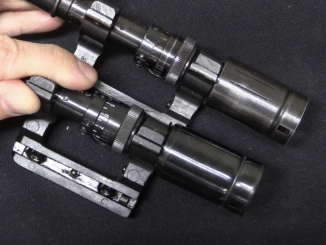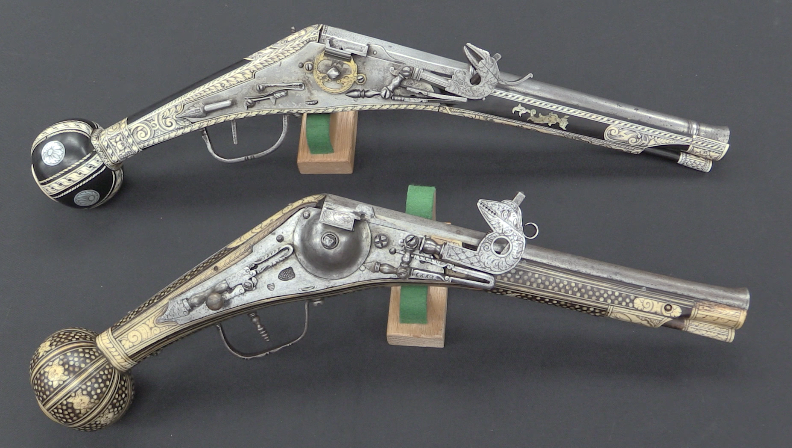While the MP5SD is made with a barrel ported right at the chamber to reduce bullet velocity, I am curious to see if it will actually work. Can I tell the difference between 115gr supersonic ammunition and 158gr subsonic? Let’s find out…
Related Articles

Optics
ZF-41: Germany’s Worst WW2 Sniper Scope
One of the pieces of feedback the German military got form he invasion of Poland in 1939 was a desire for a squad-level designated marksman in each unit. This would be a man with the […]

Semiauto Rifles
Slow Motion: Gewehr 43
The G43 was intended to become the standard infantry rifle for the Wehrmacht (replacing the Kar 98k), but production never ramped up sufficiently, and the concept of the intermediate-caliber Sturmgewehr took over by the end […]

Handgun
RIA: Real vs “Fake” Wheellocks – What is “Fake”, Anyway?
When someone makes a “fake” historical gun, they can do so with the intent to deceive or be up-front with the gun’s new manufacture. Those acknowledged reproductions are a great option to have – guns […]

Didn’t I read somewhere that HK said not to use subsonic in this gun because the bullet would have such a low velocity that it might not have enough knock down power against human targets
I definitely have the same impression about HK recommendations. Well, not “not be able to knock down human targets” just the statement that subsonic ammo will not be any quieter while also having less knockdown power. Subsonic ammo is not guaranteed to be bad, but it’s guaranteed to be no better and likely worse.
Also if you really, really care about knockdown power you are better off using subsonic ammo with a normal gun and a good suppressor, because velocity is (about)the same and subsonics have a greater mass, but I suppose HK felt that subsonic 115gr is good enough for all situations (especially if we talk about military usage where you are restricted to FMJ) where suppressed weapons would be used.
The whole point of the desing oif the MP 5SD is to be able to shoot standard issue supersonic 9*19 mm suppressed and sub-sonic. Yes it did cycle in this case with sub-sonic loads, but it is not designed for it and it invites malfunctions potentially.
It would be interesting to know if there was any type of ammunition that would fail to cycle the bolt all the way due to bleeding off of pressure. Or if an MP5SD failed to function earlier than a regular MP5 due to crud buildup. I got to shoot an MP5 range gun that was so filthy that you couldn’t get more than five rounds out at a time.
PS This is hardly a Forgotten Weapon……
…what is then if you never knew about it?
And on that note, while I prefer delayed blowback in conventional full-power subguns, HK apparently banked on nobody noticing how unnecessary it is in a gun where pressure drops drastically ~1/2″ into the rifling (and won♂️).
I think I detected a change in the ejection pattern from sub-sonic to sonic. It appeared that the sonic cases flew more to the front and the sub-sonic seemed to go straight out. Did anybody else pick up on that?
Use of a Chronograph would have been very interesting to see the comparative velocity of each of the rounds and to then calculate muzzle energy with the sonic vs. sub-sonic ammo…
I got the same impression. This make sense as bolt velocity is probably lower with subsonic ammo.
Ah…we need a trial with Glisenti 9mm. If anything would fail…
I think a lot of PD’S have a allowance for swat type weapons. At least that is what I was told about Washington state. Cosmoplis is a very small town. The PD there wore theirs out. I think they got them more for recreation than for need.
I was going to say, what kind of Rainbow Six shenanigans are going on in Cosmopolis of all places that the PD needs MP5SDs?
They do not want to wake the neighbours at night. 😉
There is a non-trivial amount of smoke venting just above the trigger assembly immediately upon firing the gun. Since this smoke appears immediately, it can’t be due to the gun getting extremely hot and burning off oil, etc. My guess is that this is due to the barrel venting which makes normally supersonic ammo subsonic. Can anyone verify if this is the case?
Probably, nevertheless, from the extraction window?
This is normal for all MP5s and their full clones. There are longitudinal grooves in the front part of the chamber, until the pressure in the brass has grown sufficiently to ensure obturation, gases pass through these grooves.
This is present on almost any pistol-chambered weapon. But not so noticeable without grooves.
By the way, this leak should increase the noise level on the right side of the device.
Perhaps this is the reason why the sound measurement data differ so markedly from different experimenters.
Therefore, the most reliable way to assess the effectiveness of suppression is not instruments, but a living observer. 😉
Cool video!
Only I can hear the difference between the first shot and the other three?
I cannot hear it, but it is a known phenomenon. First-round pop, that is, first shot sounds louder, presumably because there is a normal concentration of oxygen which reacts with incompletely burned propellant gases in the silencer during the first shot, but a low concentration afterwards. Occurs to some degree in any baffle suppressor. “Wet” suppressors do not have this problem, but they are unpopular nowadays among the police\special forces AFAIK, so the opinion seems to be “it’s not a problem worth spending time and\or money on”.
In this case also the difference in supersonic and subsonic cartridges being fired altered the sound.
Ian did everything right.
Super-sub-super-sub
The first shot is a little louder and “another”.
Also, the available measurements indicate that there is practically no difference for MP5SD.
And Sterling, with subsonic ammo, sounds noticeably quieter.
I read somewhere that if avoiding “first round pop” was crucial some operators would fire one round pre-mission and immediately put a small piece of tape over the suppressor muzzle to keep the burnt gases in. Could be an element of wishful thinking since some air would certainly seep in as the suppressor and gun returned to ambient temperature even with a closed bolt weapon in Condition 1.
Hey Ian! As I’ve commented under your YT-video to the MP5 Schalldämpfer, can you check whether the silencing system eventually goes back to an idea of Nikola Tesla and his valve? ’cause, looks very much so. Greetings from Berlin, Germany – Andi https://youtu.be/suIAo0EYwOE